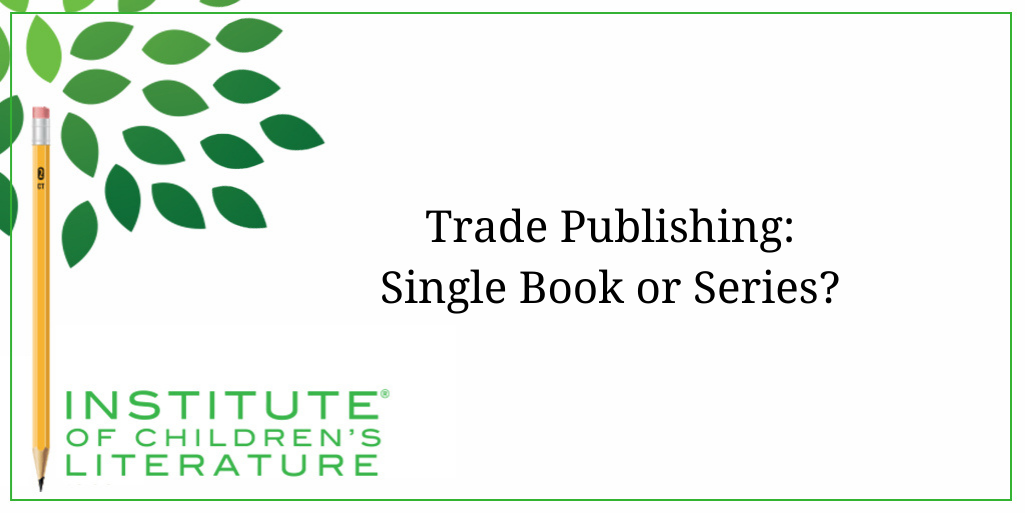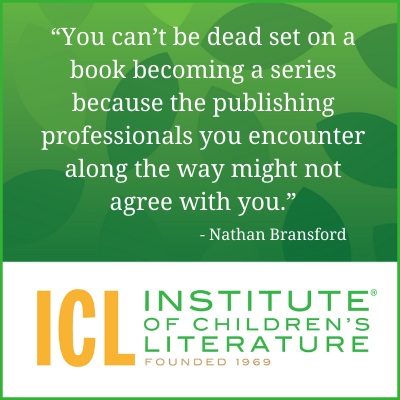
5 Ways Writers Can Prep for 2025 Goal Setting
Before we roll on to the new writing year, let’s harness our optimism for the blank slate before us and prepare for our 2025 Goal Setting just for writers.

We teach our students how to write and get published!
View our Course Catalog >
In educational publishing, series books rule. Most books, both nonfiction and fiction produced by educational publishing are part of a series. A series is simply the easiest way to package the content to be of interest in the educational setting. The buyer for educational books does not include the average consumer, so the publishers market for schools and school libraries, both of which tend to like the convenience of a series.
Trade publishing is different. Books aren’t sold to readers in collections (at least not until a full series has been released and has become wildly popular). Instead, trade publishers recognize a simple truth: when selling a series to individual readers, the first book gets the most readers. Each book after that attracts fewer and fewer of those readers. So it makes sense that a trade publisher would be more interested in individual books. But, they also understand (especially with children’s books) that kids can fall in love with characters and situations and want more and more and more from an author. Because of that, trade publishing doesn’t slam the door on the possibility of a book series. Instead, they are leery of them.
Most trade books that ultimately become series have certain things in common. They tend to have strong, unique main characters, usually active characters. They tend to have a unique, stand-out voice. The books get attention because they are unlike other books enough that they engage and offer the possibility of something special. These books sound like themselves in some unusual way. But voice and quirky character will not be enough to maintain a series. You also need something to say, and a role for the characters to fulfill.

The easiest way to create a book that will both grab a reader and lend itself to eventual series creation is to find an under-told tale. This is something many new writers fail to do. For instance, when Harry Potter came out and became such a huge phenomenon, publishers faced an onslaught of books about young magicians going to magic school (and usually working through the plots in groups of three friends.) Some of these writers truly didn’t understand that they were creating something derivative. They thought the elements that were their own would be enough to carry what felt very familiar to editors. You don’t want to wander around in the familiar. You want to explore beyond the edges of where others have already gone.
I’ve often told readers that when I study the books that publishers produce, it quickly becomes clear that what publishers are really looking for is something that is exactly the same as the hugely popular books, but completely different. Obviously, this is impossible, so some books will fall harder into the “completely different” side of the equation while others tip more into the “exactly the same.” That’s why you might pick up a book and think, “Didn’t I read something just like this?” You probably didn’t, but you have read two books that were a little too far on the “exactly the same” side.
Completely different can be problematic as well. If a book is too different, it can be difficult for a publisher to market it and difficult for bookstores to shelve it. It can be hard for readers to know if they’ll like it. There must be something in the book that lures, and if the book goes too far into uncharted territory, that lure has trouble catching. So if you’ve crafted a book that you feel is completely different, good. But now your task is to find what about the book is actually exactly the same.
Does it have the same kind of emotional connection of another book? Did it make you cry like another book? Does it explore freedom or any other idea in way that makes you think of another book? Does it open up friendships or family relationships or duty or anything in a way that puts you in mind of another book? These links can be much deeper and dive far below plot. Ask your friends and family who have read the book those kinds of questions and see what they come up with. This will help you be equipped for your book pitch. You’ll be able to tell how it is exactly the same but completely different.
The usefulness of knowing trends in trade publishing pops up at the point of marketing a strong book that you believe has series potential. This is because you’ll want to downplay dying (or dead) trends and build up trends that are only beginning to grow and bloom. This is because publishers and agents will shy away from dead trends. If your books has anything in common with a dead or dying trend (for example, a unique spin on superheroes), you want to be careful not to mention that your main character picks up super powers along the way in the story. Instead, you’ll want to look at what elements of the novel reflect things editors and agents are actually interested in and stress those. For example, he is traveling with his family so he can learn about the history of the Mayan people because his family is Mayan, though he grew up in Indiana. You decided to write his story, because it is also (in a way) your story. And it’s while on this trip that he acquires these powers in connection with his heritage. Then the point you would stress as you try to interest an agent or editor is the connection to his Mayan heritage and his exploration of family and duty and history. You’ll share that it’s an action story (as action always sells), but you’ll not put the superhero side of the story front and center. It’s there, but it’s not where you’re shining the query spotlight.
So how do you know what trends look like? You can find older, mature trade publishing trends in any bookstore or by getting the Publisher’s Weekly email about children’s books. You’ll see new books coming out. You’ll see blurbs about them. You’ll see blurbs about books selling right now (through announced deals in that newsletter). The ones in deal announcements reflect living trends. The ones in new book lists reflect mature (and even dying) trends. Another place to check is the #mswl (manuscript wish list) tag on Twitter. This hashtag is used more by agents than publishers, and they reflect a combination of what the agent personally enjoys reading and would like to see more of, and what the agent sees as a potential hot commodity, a new or building trend.
Never write to trends, but knowing the trends can help you find what part of the story you felt compelled to write will best grab an agent or editor, and will give a marketing angle after the book is published. Knowing this will help convince an editor of the potential in the title and can sometimes snag a writer a contract for more than one book (not often, but it’s been known to happen).
Ultimately the final choice of whether a book becomes a series lies with the publisher. And the choice of how long the series continues lies with the publisher as well. A writer can sometimes put the brakes on a series, but they can’t force extra books. Only eager readers can do that. So the best thing you can do to make that happen is to write the book you love with a unique voice, a memorable main character, and a story that has something to hang marketing on. It’s never a sure thing, but smart writers can make it ever so slightly surer.
With over 100 books in publication, Jan Fields writes both chapter books for children and mystery novels for adults. She’s also known for a variety of experiences teaching writing, from one session SCBWI events to lengthier Highlights Foundation workshops to these blog posts for the Institute of Children’s Literature. As a former ICL instructor, Jan enjoys equipping writers for success in whatever way she can.

Before we roll on to the new writing year, let’s harness our optimism for the blank slate before us and prepare for our 2025 Goal Setting just for writers.

Writers can be thin-skinned when it comes to getting feedback on their work. Let’s look at 4 ways to positively deal with constructive criticism!

Rejection is part of the territory when it comes to being a writer. Today we offer reflection for writers to help redirect your efforts after a rejection.
1000 N. West Street #1200, Wilmington, DE 19801
© 2024 Direct Learning Systems, Inc. All rights reserved.
1000 N. West Street #1200, Wilmington, DE 19801
© 2024 Direct Learning Systems, Inc. All rights reserved.
1000 N. West Street #1200, Wilmington, DE 19801
© 2024 Direct Learning Systems, Inc. All rights reserved.
1000 N. West Street #1200, Wilmington, DE 19801
© 2025 Direct Learning Systems, Inc. All rights reserved.
1000 N. West Street #1200, Wilmington, DE 19801
©2025 Direct Learning Systems, Inc. All rights reserved. Privacy Policy.
1 Comment